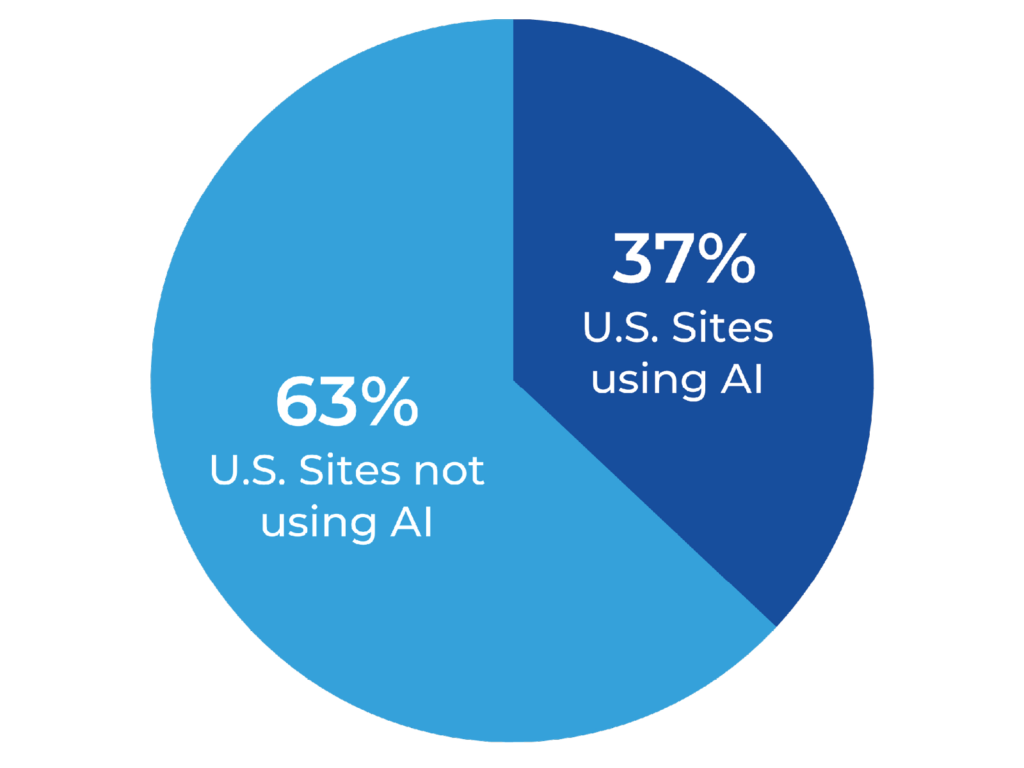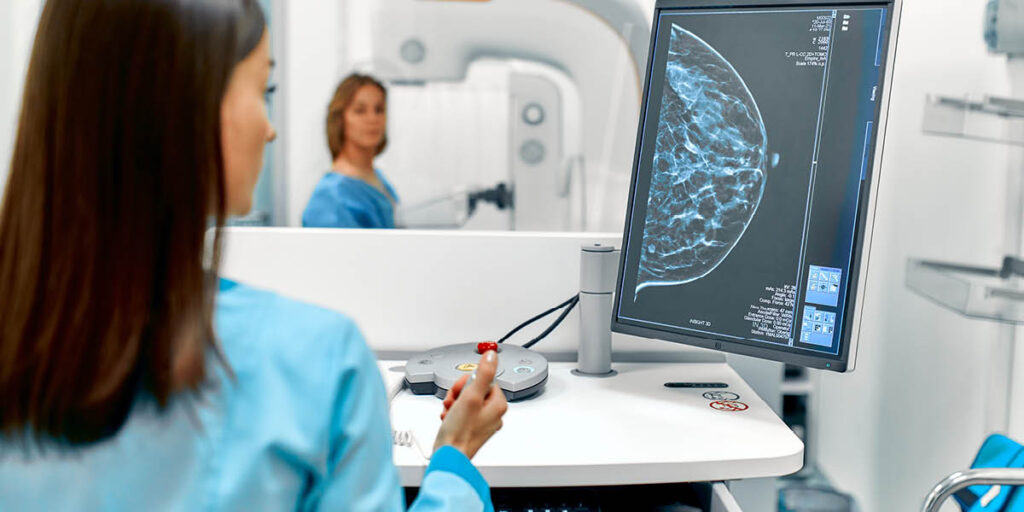Breast cancer remains a significant health concern globally, and as imaging centers strive to deliver the highest standard of care, incorporating AI into mammography workflows, emerges as a game-changing solution.
An evolving standard of care: As of 2022, over 1/3 of all US radiology sites are using AI-powered mammography, and rates are continuing to increase globally for use in both 2D and 3D mammography.
Does AI really help radiologists find more cancers? AI-Supported Mammogram Reading Detects 20% More Cancers.

This article explores the crucial business needs imaging centers face, compelling them to consider the adoption of cutting-edge AI technology in their image screening workflows.
Improve operational workflows with AI.
Address staff shortages and alleviate burnout.
The healthcare industry is grappling with a shortage of skilled radiologists, intensifying the need for solutions that optimize workforce efficiency.
“Burnout in radiology is increasing globally, with prevalence estimates reaching 88% and 62% for overall and high burnout, respectively.”1
A mammography solution assisted by AI helps bridge the gap by automating routine tasks, enabling radiologists to manage a larger workload without compromising accuracy or patient care.
Stay competitive by offering continuous technological advancements.
The landscape of medical imaging is evolving rapidly, with technological advancements reshaping the field. Imaging centers that embrace AI-powered mammography position themselves at the forefront of innovation and patient care. This not only enhances their reputation but also ensures they can leverage the latest advancements in breast cancer detection and risk prediction.
Align with Quality Care Standards to maximize patient outcomes.
Mammography readings assisted by AI is playing a role in helping breast imaging centers align to important quality standards and accreditation programs, ultimately maximizing positive patient outcomes.
• Mammography Quality Standards Act (MQSA)
• National Quality Measures for Breast Centers (NQMBC) Program
• National Accreditation Program for Breast Centers (NAPBC)
• Institute for Healthcare Improvement Quintuple Aim of Healthcare
• American College of Radiology (ACR) Accreditation Program
How do facilities quickly get in compliance with the new FDA communication requirement?
By September 2024, all US radiology facilities need to be in compliance with FDA communication requirements to notify patients if they have dense breasts, since it’s a leading breast cancer risk factor. Adopting an integrated AI-powered solution today helps to support compliance alignment before the deadline.
Increase medical professional liability (MPL) opportunities with improved performance.
AI-powered mammography is reshaping breast health diagnostics. Beyond the precision it brings to cancer detection, this cutting-edge technology significantly improves risk mitigation strategies.
The heightened performance of AI-mammography not only betters patient outcomes but also elevates opportunities for medical professional liability (MPL), significantly reducing missed or delayed diagnosis of cancer. As imaging centers embrace AI, the fusion of technology and risk management becomes evident, fostering more standardized and efficient workflows. This marks a transformative moment where advanced imaging not only saves lives but also contributes to a more resilient and effective healthcare system.
Improve clinical and diagnostic outcomes with AI.
Rising patient volumes and radiology workloads.
Imaging centers are witnessing an unprecedented increase in patient volume, placing immense pressure on imaging teams to process a higher number of mammograms efficiently. AI-powered mammography acts as a force multiplier, assisting radiologists in analyzing large quantities of imaging scans with speed, confidence, and accuracy.

With AI alleviating the strain caused by rising workloads, radiologists are able to triage high-priority cases, read more patient scans faster, and improve diagnostic accuracy compared to those that read without AI support.2
Demand for faster screening turnaround times.
Timely diagnosis is paramount in the fight against breast cancer, since early detection is proven to drastically improve the survival rate. According to the American Cancer Society, detecting breast cancer when it’s still localized has a 99% 5-year survival rate.
Traditional screening mammograms miss 20-40% of cancers, resulting in missed/delayed diagnosis due to subtle hard to visualize lesions. AI-powered software significantly reduces turnaround times by swiftly analyzing images, providing radiologists with prompt and reliable insights. This accelerated pace ensures that patients receive timely follow-up screenings, diagnoses, and treatment plans.
Reduce false positives and improve reading accuracy.
False positives in mammography screenings can lead to unnecessary anxiety and additional diagnostic procedures for patients. AI-powered mammography solutions are designed to minimize false positives by being more selective on marking lesions, offering a more accurate and reliable screening process. By enhancing the accuracy of mammogram readings, radiologists can confidently identify potential cases of breast cancer and recommend appropriate courses of action.
Enhance radiologist efficiency.
Radiologists are essential contributors to the healthcare system, and their time is a valuable resource. AI-powered mammography allows radiologists to focus more time on complex cases and patient care, while routine screenings are grouped by low risk and swiftly confirmed by the clinician. This not only improves performance but also elevates the overall quality of care provided to each patient, reducing anxiety associated with missing a cancer diagnosis. When the AI solution seamlessly integrates into their existing workflows and systems, radiologists have a valuable partner, right at their fingertips.
What are your next steps?
As radiology centers navigate the complexities of breast cancer screening, the adoption of AI-powered mammography software has become a strategic imperative.
From managing increased patient volumes and improving turnaround times to reducing false positives and enhancing radiologist performance, the business needs addressed by AI are both urgent and compelling. Embracing this transformative technology not only safeguards the well-being of patients but also positions imaging centers as leaders for more effective breast cancer detection and care.
In the next post, we address some common questions asked about AI solutions, that may delay implementing this life-saving technology. Read More
We’d love to talk with you and answer any questions you may have. We can conduct a needs assessment about your facility, and qualify how an AI-powered solution can benefit you, your clinicians, and patients.
References:
- National Library of Medicine: https://www.ncbi.nlm.nih.gov/pmc/articles/PMC10618688/ ↩︎
- Conant EF, Toledano AY, Periaswamy S, Fotin SV, Go J, Boatsman JE, Hoffmeister JW. Improving Accuracy and Efficiency with Concurrent Use of Artificial Intelligence for Digital Breast Tomosynthesis. Radiol Artif Intell. 2019 Jul 31;1(4):e180096. doi: 10.1148/ryai.2019180096. PMID: 32076660; PMCID: PMC6677281. ↩︎
